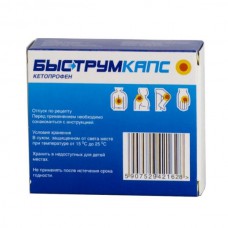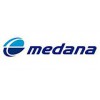Expiration date: 06/2026
Composition
1 capsule contains:
Active substance: Ketoprofen 200 mg.
Auxiliary substances Makrogol 4000, ethyl cellulose, stearic acid, ammonium methacrylate copolymer, talc, neutral granules (sugar and corn starch [3:1]).
Capsule shell Gelatin, titanium dioxide.
Packaging
In a contour acheikova packing 10 capsules. In a carton 2 contour cell package.
Pharmacological action
Bystronic - Ketoprofen is a nonsteroidal anti-inflammatory drug from the group of derivatives of propionic acid. It has the following properties:
- It has analgesic effect.
- Has a antipyretic effect.
- Shows anti-inflammatory effect.
- Inhibits platelet aggregation.
All the above properties are the result of reduction of prostaglandin synthesis by non-selective inhibition of cyclooxygenase activity of type 1 and 2.
Indications
Diseases of the musculoskeletal system and pain of different Genesis:
Symptomatic treatment of inflammatory degenerative diseases of the musculoskeletal system:
- Bursitis.
- Synovitis.
- Capsulitis.
- Tendonitis.
- Periarthritis.
- Rheumatoid arthritis.
- Osteoarthritis.
- Ankylosing spondylitis.
- Neuralgias.
- Myalgias.
- Sciatica.
- Lumbago.
- Uncomplicated injuries:
- In particular sports.
- Ligament and tendon damage.
- Injuries.
Contraindications
- Hypersensitivity to Ketoprofen or to any component of the drug (including other NSAIDs).
- Bronchial asthma, rhinitis, or urticaria in medical history caused by Ketoprofen, acetylsalicylic acid or other NSAIDs.
- eptic ulcer and 12 duodenal ulcer (exacerbation).
- Ulcerative colitis (exacerbation).
- Crohn disease.
- Diverticulitis.
- Peptic ulcer.
- Hemophilia and other blood clotting disorders.
- Active gastrointestinal, cerebrovascular and other bleeding (or the suspicion of bleeding).
- Severe renal failure (creatinine clearance less than 30 ml/min).
- The progression of kidney disease.
- Severe hepatic insufficiency or active liver disease.
- Condition after coronary artery bypass grafting.
- Confirmed hyperkalemia.
- Inflammatory bowel disease.
- Children under 15 years of age.
- Pregnancy (III trimester).
- Lactation.
With caution:
- Anemia.
- Bronchial asthma.
- Alcoholism.
- Tobacco use.
- Alcoholic cirrhosis of the liver.
- Hyperbilirubinemia.
- Liver failure.
- Dehydration.
- Sepsis.
- Chronic heart failure.
- Edemas.
- Arterial hypertension.
- Blood disorders (including leukopenia).
- Stomatitis.
- Ischemic heart disease.
- Cerebrovascular disease.
- Dyslipidemia / hyperlipidemia.
- Diabetes.
- Diseases of the peripheral arteries.
- Creatinine clearance less than 60 ml/min.
- Ulcerative lesions of the gastrointestinal tract (GIT) history.
- The presence of Helicobacter pylori infection .
- Prolonged use of NSAIDs.
- Severe somatic diseases.
Simultaneous reception:
- Oral glucocorticosteroids (GCS) (including prednisolone ).
- Anticoagulants (including warfarin ).
- Antiplatelet agents (including clopidogrel).
- Selective serotonin reuptake inhibitors (including citalopram, fluoxetine , paroxetine , sertraline ).
Application during pregnancy and breast-feeding
Contraindicated in the third trimester of pregnancy and during lactation. In the second and the first trimester of pregnancy use with caution.
Method of application and doses
By mouth.
- Adults and adolescents over 15 years of age: one capsule 200 mg once a day with meals.
Side effect
- From the digestive system of NSAIDs-gastropathy, heartburn, nausea, vomiting, diarrhea, constipation, flatulence, decreased appetite, stomatitis, abdominal pain and epigastric. Rarely-change taste. With prolonged use in high doses — ulceration of the gastrointestinal mucosa, gingival, hemorrhoidal bleeding, intestinal perforation.
- From the urinary system is Rare: cystitis, urethritis, impaired renal function, acute renal failure, interstitial nephritis, nephrotic syndrome, hematuria, edema (especially in patients with hypertension ).
- From the liver, there may be changes in the activity of transaminases. Rarely-hepatitis.
- From the nervous system Excitement, nervousness, drowsiness, depression, asthenia, headache, dizziness, sleep disturbance, insomnia, tinnitus. Rarely-confusion or loss of consciousness, forgetfulness, migraine, peripheral neuropathy.
- Cardio — vascular system, Cardiac insufficiency, increase in blood pressure. Rarely-tachycardia.
- Hypersensitivity reactions Rhinitis, angioedema, anaphylactic shock, rash, itching, urticaria, asthmatic attack, especially in patients with hypersensitivity to acetylsalicylic acid, as well as other drugs from the NSAIDs group.
- Skin reactions, Photosensitivity, alopecia areata, polymorphic erythema, exudative erythema multiforme, the Stevens-Johnson syndrome, toxic epidermal necrolysis (Lyell's syndrome).
- From the hematopoietic organs Anemia, leukopenia, thrombocytopenia, agranulocytosis, pancytopenia. Rarely-hemolytic anemia.
- Reversible toxic amblyopia, unclear vision or double vision on the part of the sensory organs. Rarely-conjunctivitis, dryness of the mucous membrane of the eye, eye pain, hyperemia of the conjunctiva, hearing loss.
- Other increased sweating. Rarely-hemoptysis, nasal bleeding, myalgia, muscle twitching, shortness of breath, thirst, with prolonged use in high doses - vaginal bleeding.
In case of any side effects, the drug should be stopped immediately.
Special instruction
During treatment, it is necessary to control the picture of peripheral blood and the functional state of the liver and kidneys.
If it is necessary to determine 17 — ketosteroids, the drug should be canceled 48 hours before the study.
Ketoprofen administration can mask the signs of an infectious disease.
At infringement of function of kidneys and liver should reduce the dose and closely monitored.
To reduce the risk of adverse effects from the blood should use the minimum effective dose is possible short course.
Effects on ability to drive vehicles and management mechanisms during the period of treatment must be careful when driving and occupation of other potentially hazardous activities, require high concentration and psychomotor speed reactions.
Drug interaction
To avoid the simultaneous application of
- Other NSAIDs (including salicylates at high doses), oral anticoagulants, heparin, ticlopidine — increased risk of bleeding. If the use of Ketoprofen is necessary, careful monitoring of the patient's condition should be carried out.
- Lithium-the risk of increasing the toxic level of lithium in plasma. If necessary, during the simultaneous use of lithium and Ketoprofen preparations, as well as after its completion, a thorough monitoring of the concentration of lithium in plasma should be carried out.
- Methotrexate (at a dose of more than 15 mg / week) — increases the risk of hematotoxicity. The intervals before and after administration of methotrexate should be not less than 12 hours from receiving Ketoprofen.
- Enhances the effect of anticoagulants, antiplatelets, fibrinolytics , ethanol, side effects of GCS and MCS, estrogens.
- Increases plasma concentrations of verapamil and nifedipine .
- Myelotoxic drugs increase the manifestations of hematotoxicity of the drug.
- Reduces the antihypertensive effect of beta-blockers.
- Increases the risk of nephrotoxic effect of beta-blockers.
- Increases the risk of nephrotoxic effect of cyclosporine and tacrolimus, especially in elderly patients.
- Reduces the contraceptive efficacy of intrauterine devices. Increases the risk of bleeding when using thrombolytics.
- Care must be taken when using C
- Diuretics and inhibitors of angiotensin converting enzyme — weakening of diuretic and antihypertensive effects and the risk of renal failure in patients with a deficiency of circulating blood.
- Pentoxifylline-increases the risk of bleeding.
- Zidovudine-increases the risk of anemia (affects reticulocytes with the development of anemia).
- As with other NSAIDs,
- Reduction of the effectiveness of uricosuric drugs.
- Increase risk of ulceration and development of gastrointestinal bleeding and the development of impaired renal function when co-administered with corticosteroids, ethanol, corticotropin.
- Increased risk of bleeding with concurrent use with cefoperazone, cefamandole and cefotetan.
- Increase hypoglycemic effect of insulin and oral hypoglycemic drugs (requires the recalculation of doses).
- Increase in the production of hydroxylated active metabolites inducers microsomal oxidation in the liver (phenytoin, ethanol, barbiturates, rifampicin, phenylbutazone, tricyclic antidepressants).
- Violation of platelet aggregation in a joint appointment with sodium valproate.
- Antacids and cholestyramine reduce the absorption.
Overdose
- Symptoms: acute poisoning, such as headache, dizziness, drowsiness, nausea, vomiting, diarrhea, pain in the epigastric region, lowering blood pressure, bronchospasm, bleeding from the gastrointestinal tract.
- reatment: immediate discontinuation of the drug. Symptomatic treatment. If the drug overdose was not more than 1 hour, gastric lavage with activated charcoal at a dose of 60-100 g in adults, 1 to 2 g/kg of body weight in children.
Storage conditions
- Store in a dry, dark place at temperatures from 15°C to 25°C.
- Keep out of reach of children.
- Do not use after the expiry date.
Shelf life
3 years.


